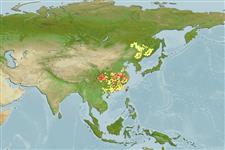Classificação / Names
Common names from other countries
Referência principal
Tamanho / Peso / Idade
Max length : 105 cm TL macho/indeterminado; (Ref. 40637); common length : 18.0 cm SL macho/indeterminado; (Ref. 35840); Peso máx. publicado: 50.0 kg (Ref. 30578)
Length at first maturity
Lm 51.7 range ? - ? cm
Ambiente
; Água doce bentopelágico; potamódromos (Ref. 51243); intervalo de profundidade 0 - 20 m (Ref. 6898)
Clima / Intervalo
Subtropical; 6°C - 28°C (Ref. 37797), preferred ?; 64°N - 43°S
Distribuição
Asia: Native to most major Pacific dainages of East Asia from Amur to Xi Jiang, China (Ref. 59043). China and Eastern Siberia. Introduced around the world for aquaculture and control of algal blooms. Several countries report adverse ecological impact after introduction (Ref. 1739). Often confused with Hypophthalmichthys nobilis (Ref. 59043).
Países | Áreas FAO | Ecossistemas | Ocorrências | Introduções
Descrição suscinta
Espinhos dorsais (total): 1 - 3; Raios dorsais (total): 6-7; Espinhos anais 1-3; Raios anais : 10 - 14. Body olivaceous to silvery. Barbels absent. Keels extend from isthmus to anus. Edge of last simple dorsal ray not serrated. Branched anal rays 12-13.5 (Ref. 13274). Differs from Hypophthalmichthys nobilis by having sharp scaleless keel from pectoral region to anal origin, 650-820 long, slender gill rakers, head length 24-29% SL, and plain pale coloration, greenish grey above, whitish below (Ref. 59043).
Status na Lista Vermelha da IUCN (Ref. 115185)
Perigo para os humanos
Potential pest
Uso pelos humanos
Pescarias: espécies comerciais; Aquacultura: espécies comerciais
Ferramentas
Relatórios especiais
Baixar XML
Fontes da internet
Estimates of some properties based on models
Phylogenetic diversity index
PD50 = 0.6250 many relatives (e.g. carps) 0.5 - 2.0 few relatives (e.g. lungfishes)
Nível Trófico
2.0 ±0.00 se; Based on food items.
Resiliência
Médio, tempo mínimo de duplicação da população 1,4 - 4,4 anos (K=0.16-0.29; tm=2-6)
Vulnerabilidade
High vulnerability (55 of 100)
Categoria de preço
